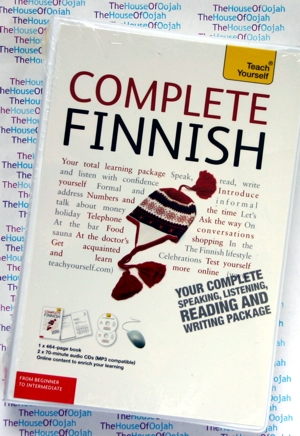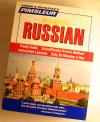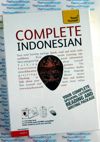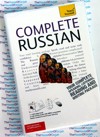Teach Yourself Complete Finnish - 2 Audio CDs and Book
Now fully updated to help with making your language learning experience fun and interactive. That you can still make use of the many benefits of a top language teacher and our many years of teaching experience, but now with added learning features inside of the course and internet based.
The course is structured in thematic units and therefore the emphasis is placed on communication, and that means you effortlessly progress from introducing yourself and providing treatment for everyday situations, to by using the phone and making reference to work.
Right at the end of this course, you're at Level B2 of the Common European Framework for Languages: Can get connected to a degree of fluency and spontaneity in which produces regular interaction with native speakers quite possible without strain for either party.
Learn effortlessly once you get your easy-to-read page design and interactive features:
NOT GOT MUCH TIME?
One, five and ten-minute introductions to key principles to find you started.
AUTHOR INSIGHTS
Quite a few instant give assistance with most popular obstacles and quick tips for success, depending on author's a number of years of experience.
GRAMMAR TIPS
Easy-to-follow building blocks to give you a clear understanding.
USEFUL VOCABULARY
To be able to find and learn, to set up a solid foundation for speaking.
DIALOGUES
Read to see everyday dialogues to help you out speak and understand fast.
PRONUNCIATION
Don't appear to be a tourist! Perfect your pronunciation before.
TEST YOURSELF
Tests ever invented and online to keep track of your progress.
MAKE THIS HAPPEN
Innovative exercises illustrate what you've learnt and exactly how to use it.
For learners who want to progress quickly beyond the basics to a level where they can communicate with confidence
The course covers topics that will appeal to those learning for holiday and business purposes
This course will appeal to beginners as well as those who want to refresh existing knowledge
Table of Contents:
Introduction
Pronunciation
Let's practise!
Nice to meet you
Welcome!
One, two, three...
Straight on
Have a pleasant journey!
Speaking on the phone
Bon appetit!
What would you like?
In the sauna: more water on the stove
Oh dear, oh dear!
Come and see us!
Tell us a little bit about yourself
Excuse me, do you speak Finnish?
What is the weather like outside?
Beware of elks on the road!
The evening news
Congratulations!
With true Finnish grit
Key to the exercises
Finnish-English vocabulary
English-Finnish vocabulary
Appendices
Taking it further
Index
About the Author:
Terttu Leney is an experienced teacher, teacher trainer, translator and broadcaster of Finnish. She has taught Finnish in various firms and language schools, at Chelsea & Westminster Adult Education Institute, the University of Surrey and has been teaching Finnish at the Foreign Office in London for over twenty years. She has taught several generations of UK diplomats to Helsinki. She has also been a freelance broadcaster for the Finnish section of the BBC World Service and Examinations Administrator for Language Testing Associates, London. In 1996 she gained a Postgraduate Diploma in Current Developments in Language Training from the University of Westminster.
About the Finnish Language 
Finnish may perhaps be the language spoken by way of the will probably be the population in Finland and by ethnic Finns beyond the borders of Finland. It can be one of the official languages of Finland as well as an official minority language in Sweden. In Sweden, both standard Finnish and Meänkieli, a Finnish dialect, are spoken. The Kven language, and that is closely related to Finnish, is definitely a official minority language in Norway. Finnish will be the eponymous member associated with the Finno-Ugric language as well as is typologically between fusional and agglutinative languages. It modifies and inflects the different types of nouns, adjectives, pronouns, numerals and verbs, depending on their roles contained in the sentence. Finnish is mostly a member of the Baltic-Finnic subgroup of the Finno-Ugric group of languages which could be a member associated with the Uralic family of languages. The Baltic-Finnic subgroup also includes Estonian along with other minority languages spoken located on the Baltic Sea.
Several theories exist as to what geographic origin of Finnish and then the other Uralic languages, on the other hand most widely held view is because originated as being a Proto-Uralic language somewhere contained in the boreal forest belt in regards to the Ural Mountains region and/or the bend of the middle Volga. The strong case for Proto-Uralic is backed up by common vocabulary with regularities in sound correspondences, not to mention by the proven fact that the Uralic languages have some of similarities in structure and grammar.
This particular martial art been posited that speakers of a Finno-Ugric language happen to be requires you're going to the region of current Finland since a minimum of 3000 BC. The Finns are definitely more genetically kind of like their Indo-European speaking neighbors in order to the speakers associated with the geographically close Finno-Ugric language, Sami. So that it may possibly be argued if you have a native Finnic population absorbed northward migrating Indo-Europeans who adopted the Finnic language, giving rise on to the modern Finns.Finnish is spoken by about 6 000 0000 people that reside mainly in Finland. There are notable Finnish-speaking minorities in Sweden, Norway, Russia, Estonia, Canada, along with the United States. Lots of the population of Finland, 91.51% at the time of 2006, speak Finnish as their first language. The remainder speak Swedish (5.5%), Sami (Northern, Inari, Skolt) along with other languages. It has achieved some popularity as being a second language in EstoniaIt is recognized as of the fact that Balto-Finnic languages evolved from the neighborhood proto-Finnic language, from which Sami was separated around 1500-1000 BC. Current research indicates there have been three if not more proto-Finnic dialects. The Baltic Finnic languages separated all over the 1st century, but continued to influence each other well. Therefore, the Eastern Finnish dialects are genetically Eastern proto-Finnic, a lot of Eastern features, and also the Southwestern Finnish dialects have some of genuine Estonian influences.
Finland was annexed to Catholic Sweden didn't remember the words Ages. Up to now, Finnish was an oral language. The french language of business was Middle Low German, the french language of administration Swedish, and religious activities were held in Latin, leaving few possibilities for Finns to build use of their mother tongue in situations as apposed to daily chores. The most important known written example of Finnish is due to this era and was found in a very German travel journal dating back to to c.1450: Mynna tachton gernast spuho somen gelen Emyna dayda (Modern Finnish: "Minä tahdon kernaasti puhua suomen kieltä, [mutta] en minä taida"; English: "I willingly would you like to speak Finnish, [but] I cannot"). Depending on the travel journal, a Finnish bishop, whose name is unknown, was behind the actual above mentioned quotation.
Modern Finnish punctuation, as well as that of Swedish, uses the colon character (:) to split up the stem of the word and also its particular grammatical ending in some instances (for example , after abbreviations), where some other alphabetic writing systems would work with an apostrophe. Suffixes are required for correct grammar, thusmaking this often applied, e.g. EU:ssa "in the EU". Elias Lönnrot as depicted in a 19th century caricature - Lönnrot made several journeys to Karelia and Eastern Finland to collect folklore, from which he compiled the Kalevala. Belonging to the 19th century Johan Vilhelm Snellman as well as others began to stress the call to improve the status of Finnish. Since the days of Mikael Agricola written Finnish ended up being used almost exclusively in religious contexts, the good news is Snellman's Hegelian nationalistic ideas of Finnish as a full-fledged national language gained considerable support. Concerted efforts were made to improve the status of the language and in order to modernize it, and in the end belonging to the century Finnish came into existence a language of administration, journalism, literature, and science in Finland, along with Swedish. Usually are contributions to improving the status of Finnish were put together by Elias Lönnrot. His impact on the development of modern vocabulary in Finnish was particularly crucial. On top of compiling the Kalevala, he acted as being an arbitrator in disputes in respect to the development of standard Finnish between the proponents of western and eastern dialects, making sure that the western dialects Agricola had preferred preserved their preeminent role, a majority of originally dialectical words from Eastern Finland were introduced up to the standard language enriching it considerably. The very first novel written in Finnish (and by just a Finnish-speaker) was Seven Brothers, published by Aleksis Kivi in 1870. |



 0 Items (Empty)
0 Items (Empty)






